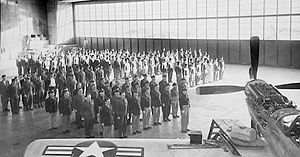Loading AI tools
Military unit From Wikipedia, the free encyclopedia
The 71st Fighter Wing (71 FW) is a disbanded unit of the United States Air Force, last stationed at Lambert Field, St. Louis, Missouri. It was withdrawn from the Missouri Air National Guard (MO ANG) and inactivated on 31 October 1950.
This article includes a list of references, related reading, or external links, but its sources remain unclear because it lacks inline citations. (January 2013) |
| 71st Fighter Wing | |
|---|---|
 124th Fighter Squadron, Iowa Air National Guard formation, Des Moines Municipal Airport, 1953 | |
| Active | 1943–1945; 1946-1950 |
| Country | |
| Branch | |
| Type | Wing |
| Role | Command and Control |
| Part of | Missouri Air National Guard |
This wing is not related to the 71st Tactical Reconnaissance Wing or subsequent units that was constituted on 18 August 1948 and activated on 25 October 1948.
Established and organized at March Field, California in 1943 as a command and control organization. Deployed to the European Theater of Operations (ETO) in late 1943 and assigned to IX Fighter Command, Ninth Air Force. Initial Mission of the Wing was to receive operational orders from Headquarters, IX Fighter Command and direct subordinate groups in attacking enemy targets in Occupied France and the Low Countries in preparation for the Normandy Invasion in June 1944. Targets included bridges, roads, railroads and enemy interceptor aircraft both on the ground as well as in air-to-air combat.
After the D-Day invasion, was directed to provide ground support for advancing United States First Army forces in France, attacking enemy targets initially in the Cotentin Peninsula, then supported Operation Cobra, the breakout of Normandy and attacked enemy forces in the Falaise-Argentan Gap.
Reassigned to IX Air Defense Command on 1 July 1944, its mission was changed to provide air defense against attacking enemy aircraft over liberated areas of France and later, the Low Countries. Wing headquarters and subordinate units operated primarily from liberated airfields and newly built temporary Advanced Landing Grounds in continental Europe. Along with air defense, subordinate units engaged in combat in support of ground forces during the breakthrough at St. Lo in July 1944. Attacked tanks, trucks, and troop concentrations as enemy retreated; provided armed reconnaissance for advancing Allied armored columns. During September 1944, attacked flak positions near Eindhoven during Operation Market-Garden, the airborne landing in the Netherlands; bombed enemy communications and transportation lines in western Germany. Flew armed reconnaissance missions over Battle of the Bulge during December 1944 – January 1944. Flew missions against enemy transportation systems including motor vehicles, bridges, trains, railway bridges, and marshalling yards during February and March 1945. Moved to Germany in April 1945, flying last combat missions on 3 May 1945.
Remained in Europe after the war as part of United States Air Forces in Europe, performing occupation duty and the destruction or shipment to the United States of captured enemy combat equipment. Demobilized in Germany and organization was inactivated as an administrative unit in the United States, December 1945.
Allocated to the Missouri Air National Guard for command and control origination for units in the Midwest Region (North & South Dakota, Minnesota, Nebraska, Iowa, Kansas, Missouri) of the United States. Extended federal recognition and activated on 3 July 1946.
At the end of October 1950, the Air National Guard converted to the wing-base (Hobson Plan) organization. As a result, the wing was withdrawn from the Missouri ANG and was inactivated on 31 October 1950. The 131st Composite Wing was established by the National Guard Bureau, allocated to the state of Missouri, recognized and activated 1 November 1950; assuming the personnel, equipment and mission of the inactivated 71st Fighter Wing.
|
|
![]() This article incorporates public domain material from the Air Force Historical Research Agency
This article incorporates public domain material from the Air Force Historical Research Agency
Seamless Wikipedia browsing. On steroids.
Every time you click a link to Wikipedia, Wiktionary or Wikiquote in your browser's search results, it will show the modern Wikiwand interface.
Wikiwand extension is a five stars, simple, with minimum permission required to keep your browsing private, safe and transparent.